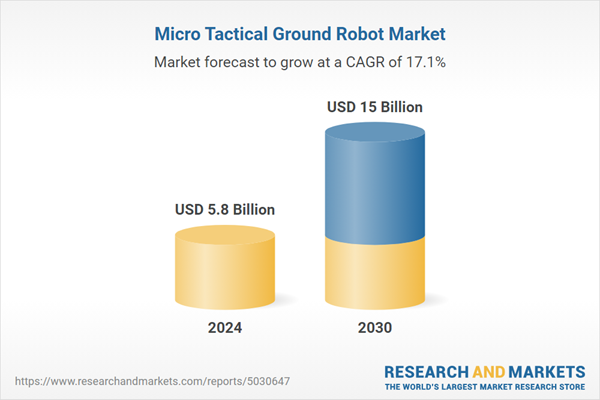Global Micro Tactical Ground Robot Market - Key Trends & Drivers Summarized
What Are Micro Tactical Ground Robots, and Why Are They So Crucial in Modern Defense and Security Operations?
Micro Tactical Ground Robots are compact, lightweight, remotely operated robots designed for surveillance, reconnaissance, bomb disposal, and various tactical operations. Typically weighing less than 10 kilograms, these robots are equipped with sensors, cameras, and communication systems that allow users to gather intelligence, inspect hazardous areas, and perform tactical tasks remotely. They are primarily used by military forces, law enforcement agencies, and emergency response teams to enhance situational awareness, reduce risks to personnel, and provide real-time intelligence in challenging environments.The importance of micro tactical ground robots lies in their ability to operate in confined, dangerous, or hard-to-reach areas where human presence is risky or impossible. They offer capabilities like navigating narrow spaces, climbing stairs, and withstanding harsh conditions, making them indispensable tools for counter-terrorism, surveillance, search and rescue, and explosive ordnance disposal (EOD) missions. As global security concerns rise and the demand for unmanned systems grows, micro tactical ground robots are becoming essential components of modern defense and public safety strategies.
How Are Technological Advancements Shaping the Micro Tactical Ground Robot Market?
Technological advancements have significantly enhanced the performance, versatility, and autonomy of Micro Tactical Ground Robots, driving innovation across military and law enforcement applications. One of the major developments is the integration of advanced sensors and AI-driven analytics. These robots now come equipped with thermal imaging cameras, night vision, 3D mapping sensors, and AI-based object detection, which improve their ability to identify threats, obstacles, and targets in various environments. AI also enables these robots to analyze gathered data in real time, providing operators with actionable intelligence, such as identifying explosives or detecting human presence in obscured or dark conditions.The development of autonomous navigation systems has further improved the capabilities of micro tactical ground robots. Autonomous features, powered by machine learning algorithms, allow these robots to map unknown terrains, avoid obstacles, and perform missions with minimal human intervention. This capability is particularly valuable in reconnaissance missions, where stealth and rapid intelligence gathering are crucial. The use of advanced SLAM (Simultaneous Localization and Mapping) algorithms enables these robots to generate real-time maps of their surroundings, enhancing situational awareness and operational effectiveness.
Advancements in miniaturization and rugged design have made micro tactical ground robots more agile, durable, and adaptable to diverse mission scenarios. Improvements in battery technology, such as longer-lasting lithium-ion and solid-state batteries, have increased the operational range and endurance of these robots, allowing for extended missions without frequent recharging. The use of lightweight, robust materials like carbon fiber and reinforced composites has enhanced their durability, enabling them to withstand harsh environments, including extreme temperatures, water, and rough terrains. These technological innovations not only expand the capabilities of micro tactical ground robots but also align with broader trends toward autonomy, improved reconnaissance, and rapid response in modern defense and security operations.
What Are the Emerging Applications of Micro Tactical Ground Robots Across Different Sectors?
Micro Tactical Ground Robots are finding expanding applications across various sectors, driven by the need for advanced surveillance, reconnaissance, and tactical operations in diverse environments. In the defense sector, these robots are used by military forces for urban warfare, reconnaissance, and battlefield intelligence. They assist in assessing enemy positions, detecting improvised explosive devices (IEDs), and conducting surveillance missions in hostile territories, all while minimizing risk to soldiers. Micro robots are also deployed in special operations, where their small size and low noise output make them ideal for stealth missions, intelligence gathering, and target acquisition.In law enforcement, micro tactical ground robots play a critical role in counter-terrorism, bomb disposal, and hostage rescue operations. They are used to inspect suspicious packages, enter buildings during standoffs, and provide real-time visuals to negotiators and tactical teams, ensuring safer outcomes in high-risk situations. By providing a safer alternative to human personnel in potentially hazardous situations, these robots help law enforcement agencies enhance their operational effectiveness while reducing casualties.
In the emergency response sector, micro tactical ground robots are employed in disaster relief, search and rescue, and hazardous material inspection. They are capable of navigating through debris, rubble, and confined spaces to locate trapped individuals, assess structural integrity, and identify hazardous materials in disaster-stricken areas. In industrial settings, micro robots are used for inspection and maintenance of hard-to-reach equipment and infrastructure, such as pipelines, reactors, and mines, where human entry is limited or dangerous. The expanding applications of micro tactical ground robots across these sectors highlight their critical role in enhancing safety, increasing situational awareness, and supporting effective decision-making in both combat and civilian scenarios.
What Drives Growth in the Micro Tactical Ground Robot Market?
The growth in the Micro Tactical Ground Robot market is driven by several factors, including increasing demand for unmanned systems, rising global security threats, and advancements in robotics technology. One of the primary growth drivers is the growing emphasis on soldier safety and minimizing human exposure to danger. As military and law enforcement agencies prioritize reducing casualties and increasing operational efficiency, micro tactical ground robots offer a practical solution for performing high-risk tasks remotely. Their ability to operate in confined spaces, identify threats, and provide real-time intelligence makes them indispensable tools in modern defense and security operations.Rising global security threats, such as terrorism, insurgency, and asymmetric warfare, have further fueled the demand for micro tactical ground robots. As threats become more complex and unpredictable, security forces require advanced tools to enhance reconnaissance, surveillance, and tactical operations. Micro tactical ground robots provide critical support in detecting IEDs, identifying hidden threats, and gathering intelligence in urban and combat environments, making them vital assets in counter-terrorism and military missions.
Advancements in robotics and AI technologies have significantly contributed to the adoption of micro tactical ground robots. Improvements in AI algorithms, autonomous navigation, and sensor integration have made these robots more capable, reliable, and adaptable to various mission requirements. Additionally, the development of rugged, all-terrain designs and longer battery life has improved the operational range and versatility of these robots, making them suitable for diverse applications, from military operations to civilian rescue missions.
Government investments and defense modernization programs have also played a key role in driving market growth. Many countries are investing heavily in unmanned ground vehicles (UGVs) as part of broader efforts to enhance defense capabilities and maintain tactical superiority. The procurement of micro tactical ground robots is supported by government funding, defense contracts, and initiatives aimed at integrating unmanned systems into national security strategies.
With ongoing innovations in autonomy, AI-driven analytics, and rugged design, the micro tactical ground robot market is poised for continued growth. These trends, combined with increasing demand for safer, more efficient tactical tools, make micro tactical ground robots a vital component of modern defense, security, and emergency response strategies focused on enhancing situational awareness, operational effectiveness, and personnel safety across various sectors.
Report Scope
The report analyzes the Micro Tactical Ground Robot market, presented in terms of units. The analysis covers the key segments and geographic regions outlined below.Segments: Application (Intelligence, Surveillance, and Reconnaissance, Law Enforcement, Explosive Ordinance Disposal, CBRNE and Hazardous Material (HAZMAT), Other Applications); Mode of Operation (Tethered, Tele-Operated, Semi-Autonomous, Autonomous).
Geographic Regions/Countries: World; United States; Canada; Japan; China; Europe (France; Germany; Italy; United Kingdom; and Rest of Europe); Asia-Pacific; Rest of World.
Key Insights:
- Market Growth: Understand the significant growth trajectory of the Intelligence, Surveillance, and Reconnaissance segment, which is expected to reach US$2.8 Billion by 2030 with a CAGR of a 15.5%. The Law Enforcement segment is also set to grow at 16.4% CAGR over the analysis period.
- Regional Analysis: Gain insights into the U.S. market, valued at $1.6 Billion in 2024, and China, forecasted to grow at an impressive 16.3% CAGR to reach $2.3 Billion by 2030. Discover growth trends in other key regions, including Japan, Canada, Germany, and the Asia-Pacific.
Why You Should Buy This Report:
- Detailed Market Analysis: Access a thorough analysis of the Global Micro Tactical Ground Robot Market, covering all major geographic regions and market segments.
- Competitive Insights: Get an overview of the competitive landscape, including the market presence of major players across different geographies.
- Future Trends and Drivers: Understand the key trends and drivers shaping the future of the Global Micro Tactical Ground Robot Market.
- Actionable Insights: Benefit from actionable insights that can help you identify new revenue opportunities and make strategic business decisions.
Key Questions Answered:
- How is the Global Micro Tactical Ground Robot Market expected to evolve by 2030?
- What are the main drivers and restraints affecting the market?
- Which market segments will grow the most over the forecast period?
- How will market shares for different regions and segments change by 2030?
- Who are the leading players in the market, and what are their prospects?
Report Features:
- Comprehensive Market Data: Independent analysis of annual sales and market forecasts in US$ Million from 2024 to 2030.
- In-Depth Regional Analysis: Detailed insights into key markets, including the U.S., China, Japan, Canada, Europe, Asia-Pacific, Latin America, Middle East, and Africa.
- Company Profiles: Coverage of players such as Boeing Company, Clearpath Robotics, Inc., iRobot Corporation, Northrop Grumman Corporation, Perrone Robotics and more.
- Complimentary Updates: Receive free report updates for one year to keep you informed of the latest market developments.
Some of the 47 companies featured in this Micro Tactical Ground Robot market report include:
- Boeing Company
- Clearpath Robotics, Inc.
- iRobot Corporation
- Northrop Grumman Corporation
- Perrone Robotics
- QinetiQ Group PLC
- ReconRobotics, Inc.
- Roboteam
- Robotnik Automation S.L.L.
- Thales Group
Tariff Impact Analysis: Key Insights for 2025
Global tariff negotiations across 180+ countries are reshaping supply chains, costs, and competitiveness. This report reflects the latest developments as of April 2025 and incorporates forward-looking insights into the market outlook.The analysts continuously track trade developments worldwide, drawing insights from leading global economists and over 200 industry and policy institutions, including think tanks, trade organizations, and national economic advisory bodies. This intelligence is integrated into forecasting models to provide timely, data-driven analysis of emerging risks and opportunities.
What’s Included in This Edition:
- Tariff-adjusted market forecasts by region and segment
- Analysis of cost and supply chain implications by sourcing and trade exposure
- Strategic insights into geographic shifts
Buyers receive a free July 2025 update with:
- Finalized tariff impacts and new trade agreement effects
- Updated projections reflecting global sourcing and cost shifts
- Expanded country-specific coverage across the industry
Table of Contents
Companies Mentioned (Partial List)
A selection of companies mentioned in this report includes, but is not limited to:
- Boeing Company
- Clearpath Robotics, Inc.
- iRobot Corporation
- Northrop Grumman Corporation
- Perrone Robotics
- QinetiQ Group PLC
- ReconRobotics, Inc.
- Roboteam
- Robotnik Automation S.L.L.
- Thales Group
Table Information
| Report Attribute | Details |
|---|---|
| No. of Pages | 197 |
| Published | April 2025 |
| Forecast Period | 2024 - 2030 |
| Estimated Market Value ( USD | $ 5.8 Billion |
| Forecasted Market Value ( USD | $ 15 Billion |
| Compound Annual Growth Rate | 17.1% |
| Regions Covered | Global |









